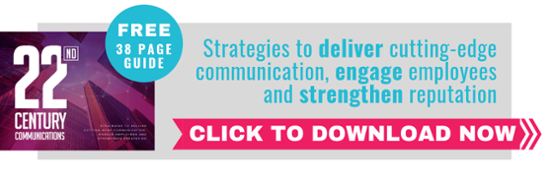
A proven formula for organizational success involves employee engagement, which we define as the emotional connection people have with work, which leads to discretionary effort – extra time, energy, brainpower, a willingness to take on a stretch assignment, and more. In other words, engaged employees are highly motivated to help an organization achieve its goals. And multiple research studies show that companies with engaged employees have better financial results.
Communications is a driving force for engagement. It is the spark that keeps the emotional attachment alive even in challenging times for an organization. By communicating information employees need to do their jobs, they see how what they do matters. Likewise, hearing about an organization’s future plans, achievements and even problems or issues creates opportunities for those in the organization to gain perspective on their own futures and make significant contributions to everyone’s success. Employees usually prefer to get this kind of information from interactions with their supervisors and managers, as well as from each other. Being treated fairly and with respect also helps them feel engaged.
There is a clear link between communication and employee engagement. In fact, research shows that companies that communicate effectively are four times as likely to report high levels of employee engagement.
Why does employee engagement matter?
Employees who are engaged are much more likely to go “above and beyond” in their work every day. They are less likely to leave for another job. And they are more productive. According to a meta-analysis of employee engagement, companies with high workforce engagement perform better than companies with low workforce engagement including:
- 37% lower absenteeism
- 41% fewer safety incidents
- 41% fewer quality defects
On the flip side, disengaged workers have been shown to cost the U.S. economy somewhere between $483 and $605 billion annually in lost productivity.
Employee Engagement Surveys
 Your communication efforts and employee engagement need to be continually monitored to assess their effectiveness. A formal way to take these measures of your performance is an annual (or even more frequent) survey, such as the Great Place to Work or Gallup surveys, or others from the many fine consulting organizations in the industry. Beyond creating an engagement score for your organization, these surveys will help you understand employees’ broad needs and identify opportunities for improvement. The one drawback is that engagement surveys often don’t focus on the importance of communication. There isn’t enough data to know what to stop, start, or continue.
Your communication efforts and employee engagement need to be continually monitored to assess their effectiveness. A formal way to take these measures of your performance is an annual (or even more frequent) survey, such as the Great Place to Work or Gallup surveys, or others from the many fine consulting organizations in the industry. Beyond creating an engagement score for your organization, these surveys will help you understand employees’ broad needs and identify opportunities for improvement. The one drawback is that engagement surveys often don’t focus on the importance of communication. There isn’t enough data to know what to stop, start, or continue.
To meet that gap, many organizations are supplementing their engagement survey with a specific communications climate survey. This survey, often done in alternate years to the engagement survey, would focus on areas such as:
- How employees prefer to receive information
- Potential gaps, whether within messaging, communication channels, technologies, managers, or leaders
- The overall effectiveness of internal communications
- Which leaders need additional support, along with learning who’s communicating effectively
Leader’s Role
Last but not least, any discussion of engagement needs to address the critical role leaders play in these efforts. Particularly, senior leaders must have a willingness to be visible and role model what it means to share meaningful information to employees. This isn’t a one time “town hall”; this is regular, consistent, authentic communication that builds awareness and understanding and also creates dialogue.
Whether its in your detailed job description or not, leaders at every level of an organization have an important and specific role to connect the dots between the big business picture and what it means for employees.
Specifically, the role of a leader is to:
- Seek out and provide context for organizational information to ensure your team clearly understands how its priorities and goals fit into the organization’s and the workgroup’s overall priorities and goals
- Make information relevant so every employee understands how he or she fits in
- Provide job-related information so your team receives essential information to help them do its job effectively
- Provide information and feedback on individual performance and other employee-related matters (e.g., recognition of achievements and contributions)
For leaders, this means:
- Open communication with employees
- Sufficiently informing employees so they:
- Know and understand the organization and work group’s business goals and strategy
- Understand how the goals and objectives of their work group or team fit into the organization’s overall future direction
- Understand how the organization is performing as well as their business unit’s and specific work group’s or team’s performance
- Encouraging constructive debate
- Encouraging sharing of ideas about important issues facing the organization
- Informing employees of reasons behind the decisions that affect them
- Listening
How engaged are your employees today? What is the impact of your communication efforts on this engagement?
—David Grossman
Click below to download—22nd Century Communications: Strategies to Deliver Cutting-Edge Communication, Engage Employees and Strengthen Reputation—and get key insights into the top 10 principles some of the best organizations employ to ensure their communication strategy is a positive lever in building a stronger business. 
Other posts you might be interested in
View All Posts
Employee Engagement
14 min read |
June 5, 2023
Two-Way Communication: 4 Tips and Examples for Getting It Right
Read More
Employee Engagement
3 min read |
October 29, 2021
The Top 10 Steps for Leaders to Improve the Employee Experience
Read More
Employee Engagement
6 min read |
February 22, 2021

Comments on this post